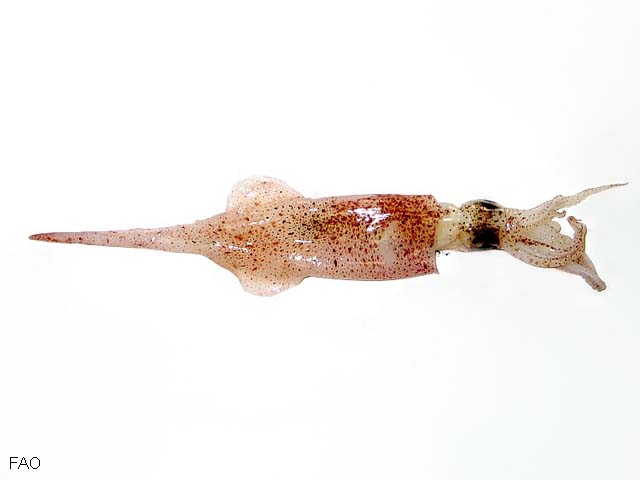| Loliginidae (inshore squids) |
| 21.5 cm ML (male/unsexed); 15 cm ML (female); max. reported age: 1 years |
|
demersal; marine; depth range 0 - 630 m |
| Eastern Atlantic and the Mediterranean: In the northeast Atlantic and Mediterranean between 20° and 60° N. |
|
Juveniles develop a bullet-shaped body, have paddle-shaped terminal fins from a simple point at the tip, and the apex later extends into a tail. Adults are typical myopsid squid, with a long muscular mantle and well-defined fins, fins originate in the posterior mantle and extend to the apex, fin width is at least 25% of ML, longest arm is 20-25% of ML, tentacles are considerably shorter than the head and mantle with narrow clubs that have pairs of central suckers attached obliquely to the club axis at an angle, suckers are biserial on the arms, and in four rows on the narrow tentacular clubs tentacle club arrangement is similar in juveniles and adults with suckers of the median rows 3-4 times larger than those of the marginal rows, median suckers are attached obliquely at a 45 degree angle, left ventral arm (IV) is hectocotylized in mature males, 6-8 pairs of proximal suckers which are unmodified and two distal longitudinal rows of fine papillae. |
| Max length of female from Ref. 275. Females grow bigger than males (Ref. 3722). Neritic, demersal (Ref. 104428). Common in shallow waters (Ref. 104148). Found in the continental shelf (Ref. 104149), shelf break front (Ref. 122864) and upper/middle slope (Ref. 105634). Recorded in subtidal Zostera marina meadows (Ref. 113974). Mainly feeds on small fish (Ref. 104428), also feeds on amphipods, copepods, decapods, euphausiids and mysids (Ref. 107015). Preyed upon by seabird, marine mammals, fish and squids (Ref. 104428). |
|
Data deficient (DD); Date assessed: 15 July 2015 Ref. 123251)
|
|
|
Source and more info: www.sealifebase.org. For personal, classroom, and other internal use only. Not for publication.

